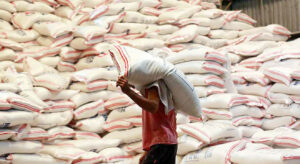Rice prices expected to rise by up to P5 on reduced imports

THE RETAIL price of rice is expected to rise by up to P5 this year due to lower import volume, according to a Department of Agriculture (DA) official.
“For now, we are seeing a maximum (increase) of P5 per kilo. But (thanks to government action) maybe it won’t go that high,” DA Deputy Spokesperson Rex C. Estoperez said in a briefing Tuesday.
As of March 30, the Bureau of Plant Industry (BPI) estimated that the volume of imported rice landed in the country fell 16.20% year-on-year to 360,196.175 metric tons (MT).
Under Republic Act No. 111203 or the Rice Tariffication Law, private parties may import rice without restriction, though incoming shipments of Southeast Asian grain must pay a 35% tariff.
Mr. Estoperez said the DA is seeking to unravel why rice inventories fell despite substantial imports last year.
The Philippine Statistics Authority (PSA) said the national rice inventory as of Jan. 1 declined 5.1% year-on-year to 1.77 million MT.
“Nagtataka rin kami (We have been wondering why) because we had imports of 3.8 million metric tons last year. What happened to those stocks?on.”
He said prices could be kept in check if imports of rice are fast-tracked.
Samahang Industriya ng Agrikultura (SINAG) Executive Director Jayson H. Cainglet that the projected increase reflects higher global rice prices.
“Precisely because of the reliance on imports, especially in the last three years, hindi natugunan yung pagtulong sa rice farmers (aid to rice farmers was not addressed), in terms of reducing their cost of producing palay (unmilled rice),” he said in a Viber message.
According to Mr. Cainglet, the average farmgate price of palay is currently between P19 and P20 per kilogram.
“Time and again, we have said that imports will not ‘tame high prices,’ across commodities. It is also happening in pork, chicken, sugar, fish products, and onions,” he said.
Mr. Cainglet reiterated that the agriculture department must instead help farmers boost productivity.
“Unless producers are encouraged to farm or raise animals; retail prices will never go down, and stocks will continue to dwindle,” he said.
As of Tuesday, domestically-produced regular milled rice is being sold in Metro Manila at between P34 and P40 per kilo, according to DA price monitoring reports. Imported regular-milled rice prics were sellng for between P37 and P44 per kilo.
RICE BUFFER STOCKRice import liberalization program has relegated the National Food Authority (NFA) to maintaining an emergency rice buffer stock, sourced from domestic farmers.
“For now, I don’t have the figure (for rice buffer socks) pero mababa siya (but it’s low). Maybe in the next few days we will know if there’s a recommendation that the National Food Authority should import (to add to the) buffer stock,” he told reporters in response to a query about the NFA’s holdings.
“NFA is not allowed to import under the Rice Tariffication Law, but if the buffer stock went down, (we need to find out because) we are talking about buffer stock,” he added.
The law also allows the NFA to regularly replenish the inventory and sell to avert spoilage if it does not distribute rice in the absence of calamites.
Mr. Estoperez said that the current procurement price of rice has increased to P22 – P23 per kilo from P19 per kilo, with increaed procurement meaning increased subsidy.
“Mukhang mahirap bawiin ‘yan pag tinaas mo na (It’s hard to bring down the subsidized price if it is raised), so we’d rather suggest that the procurement price serves as an incentive because prices fluctuate every season.” – Sheldeen Joy Talavera




